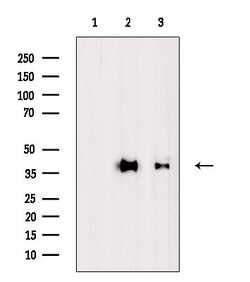Promotional price valid on web orders only. Your contract pricing may differ. Interested in signing up for a dedicated account number?
Learn More
Learn More
Invitrogen™ MUL1 Polyclonal Antibody
Rabbit Polyclonal Antibody
Supplier: Invitrogen™ PA5100877
Description
Antibody detects endogenous levels of total MUL1.
E3 ubiquitin-protein ligase that plays a role in the control of mitochondrial morphology. Promotes mitochondrial fragmentation and influences mitochondrial localization. Inhibits cell growth. When overexpressed, activates JNK through MAP3K7/TAK1 and induces caspase-dependent apoptosis. E3 ubiquitin ligases accept ubiquitin from an E2 ubiquitin-conjugating enzyme in the form of a thioester and then directly transfer the ubiquitin to targeted substrates.
Specifications
| MUL1 | |
| Polyclonal | |
| Unconjugated | |
| MUL1 | |
| 0610009K11Rik; AV000801; C1orf166; E3 SUMO-protein ligase MUL1; E3 ubiquitin ligase; E3 ubiquitin-protein ligase MUL1; Gide; growth inhibition and death E3 ligase; MAPL; mitochondria-anchored protein ligase; mitochondrial E3 ubiquitin ligase 1; mitochondrial E3 ubiquitin protein ligase 1; mitochondrial ubiquitin ligase activator of NF-kB; mitochondrial ubiquitin ligase activator of NFKB 1; Mitochondrial-anchored protein ligase; MUL1; MULAN; Putative NF-kappa-B-activating protein 266; RGD1309944; ring finger protein 218; RING-type E3 ubiquitin transferase NFKB 1; RNF218; RP11-401M16.2 | |
| Rabbit | |
| Affinity Chromatography | |
| RUO | |
| 298576, 68350, 79594 | |
| -20°C | |
| Liquid |
| Western Blot | |
| 1 mg/mL | |
| PBS with 50% glycerol and 0.02% sodium azide; pH 7.4 | |
| Q8VCM5, Q969V5 | |
| MUL1 | |
| A synthesized peptide derived from human MUL1(Accession Q969V5), corresponding to amino acid residues V191-K241. | |
| 100 μL | |
| Primary | |
| Human, Mouse, Rat | |
| Antibody | |
| IgG |
Safety and Handling
WARNING: Cancer - www.P65Warnings.ca.gov
Product Content Correction
Your input is important to us. Please complete this form to provide feedback related to the content on this product.
Product Title
Spot an opportunity for improvement?Share a Content Correction
